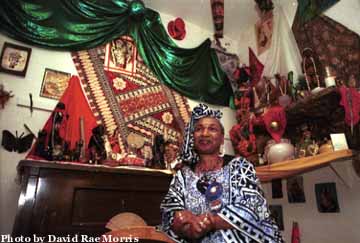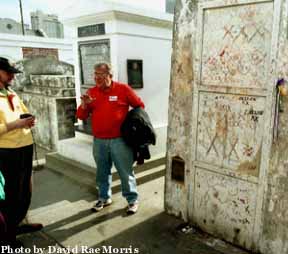Feature Inside a Voodoo Temple By Brooks Boliek
What is this thing called voodoo that haunts our collective psyche, nurtured on B-movies, filled with stiff-armed, flesh-eating zombies and secret rites carried out in the dark corners of the world? I had searched the Internet, interviewed academics, read a book about it. But now was the time to come face-to-face with it, and that face was Miriam Chamani's. Chamani is a handsome woman. Her ebony face reflects a strength and serenity. She met me in the anteroom to her temple. It is a plain room on the ground floor of her house. She was dressed in a striking black and white dashiki with a matching headdress. Her handshake was firm. The hand that grasped mine felt work-hardened. At her invitation I followed her through a narrow kitchen, where a thin old woman was working. There was a jar of brown liquid cooling on the stove. The narrow kitchen opened up onto a courtyard, where a rooster and a couple of chickens clucked in a pen on one side. We made a U-turn and stepped into the one of two rooms of her temple proper. In contrast to the plain entry room, The Voo Doo Spiritual Temple assaults the senses. It's a hodgepodge of shrines, which are in turn a hodgepodge of what look like cast-off items. A six-inch tall model of the Statue of Liberty, hubcaps from a Cadillac and a Toyota, candles, bits of food, a cup of black coffee, bottles of booze. There is the smell of incense. The sound of dripping water. The sun is filtered through a multi-colored kerchief with an image of the Virgin Mary. It felt warm. And there was the snake. "There's a snake in here," I said looking at one of the shrines. A boa was curled in the corner of a box. There were two children's crutches that made an X inside. The top was dominated by a neon-green, blood-red and black rendition of Medusa. "That's Miss Ayida," Chamani said. "Ayida came to me in a vision. That was in '90. She came and danced before me. When I told my husband about it, he went out and bought a bald python. He got sick and died. So we got her in 1991. She's a very beautiful spirit. The other snake was much more aggressive." Ayida is gateway, a channel to the loa, Chamani explained. When the pair dance, and sing to the loa Damballah, a voodoo spirit, visits Chamani and Ayida. Damballah's image is the snake. Damballah's mate, Ayida is the rainbow. The serpent and the rainbow are two of the most important voodoo loa. In the voodoo legend, they created the world. Chamani's Ayida helps bring the loa into her body during voodoo rituals. When this happens, she is said to be mounted by the spirit. Chamani's body is there, but it is her spirit has been taken up by the loa. It's a form of possession that is at the core of the voodoo belief. "It's electrical," she explained. "It works out like an electrical eel. The spirit has that kind of energy. The spinal chord is like the serpent. The energy works out of the spine like your nerves." Chamani speaks with an accent that reminiscent of the Caribbean, but she is from Mississippi. She's in New Orleans, one of the voodoo capitals, by way of Chicago where she met her late husband. He was a houngan, a voodoo priest. They were on their way to Belize, her husband's homeland, but settled in New Orleans after meeting Charles Gondolfo, curator of the New Orleans Historical Voodoo Museum. "There was a flow of energy," she said. "We were secured by the spirit." Most experts agree that voodoo, in its different spellings, is the religion of the slaves. It was spread throughout the world by the African diaspora. While it is the national religion of Haiti, it has practitioners just about wherever African people landed.
For years voodoo was an anachronism of the South. It was often called Hoodoo and showed up in the countryside and in the cities. Charleston, New Orleans, Savannah, Mobile became hotbeds of the religion because they were major slave-trading markets. The religion grew, even though the slave-trading powers were Catholic and tried to stamp it out. "It's not really a West African religion," said Bob Corbett, a University of St. Louis professor of philosophy, who has become an expert on the religion. "It's unique to the New World. It's a syncretism. An amalgam of Roman Catholicism and African spiritualism. Once it began in the New World, it took a different path from the spiritualism of Africa." The slave masters attempted to end the spiritualism of the Africans, and since the slave traders were generally French and Spanish they wanted the slaves to become Catholics, Corbett said. The slaves looked at the saints, and thought they looked an awful lot like the loa so they often grafted the characteristics of the saints onto the loa. This duality is best exemplified in the character of Marie Laveau, the so-called popess of voodoo. Laveau was a devout Catholic who won the right to openly hold voodoo ceremonies. Laveau was revered and some say feared for here psychic powers. While she was mythologized as a seer, her most potent attribute may have been that she was a hairdresser who parlayed the gossip she heard into predictions of the future. Her purported tomb is next to Mayor Ernest Morial's in the St. Louis No. 2 cemetery, although no one is sure there's a body in it. Since the organized persecution of voodoo has stopped, the religion has come out of the darkness and is practiced openly by people like Chamani and her followers. "Most of voodoo is about healing," Corbett explained. "What I've found in my work is that voodoo is a world view. Like all religions it seeks to explain the way things work. From our point of view in the 21st Century, voodoo looks absurdly superstitious, but if you look at the Christians in the dark ages, it looks a lot like voodoo." Chamani does not talk directly of healing. She talks about helping people find a balance. If something is out of whack, there are voodoo charms and ceremonies that can help put it back in shape. Some of these charms include mojo, or gris-gris bags and include animal sacrifices. While Chamani admitted that there are rites that include a sacrifice, it is not something to be taken lightly. "It is not done in the voodoo order until one understands what's going on," she said. "It can be a big part of a ceremony, but not today until people fully understand and use it properly." By making a sacrifice, the voodooist believes that he is releasing the life force of the animal to the loa. In voodoo there is no heaven or hell. The various bottles of booze and bits of food and knickknacks on the altars are also offerings to the loa, in hopes of releasing some of this energy. To a voodooist, what a Christian might refer to as the soul, comes in two parts. The 'tit bon ange makes up a person's character, while the gros bon ange is an aspect that is shared with all sentient beings. It is constantly recycled. And this is where the zombie comes in as the 'tit bon ange is captured through a spell put on the person by a sorcerer called a bokor. Without the 'tit bon ange, the gros bon ange can still move around, but he is soulless and without will. The idea of zombification is a hotly debated topic among those who study the religion. It is thought that the toxins from the puffer fish or other animals slow a person's life-signs to the insignificant for a time. The zombie-to-be is buried and then is "awakened" and given another powerful drug, if it works. While the puffer-fish poison can slow the body way down, it can also kill it. Making a zombie, or casting a spell on someone is but a small part of the religion. A bokor who casts a spell is said to be practicing voodoo "with the left hand." While zombification is an open debate, Corbett says that it is used as an ultimate punishment. "It's a social punishment," Corbett explained. "The ultimate capital punishment of the 17th and 18th century. It's a process that fundamentally destroys the frontal lobes of the brain." Chamani does not doubt that a zombie can be made, but she was more circumspect about them than Corbett. "People learn many tricks in the herbs," she said. "What herbs will do and how a person can become a victim. There are herbs that are poisonous in nature, and dangerous, and if people haven't used them properly they will get a zombie. We have zombies on this world because they are getting into certain substances. Any substance can make somebody suffer when it is not used properly." After talking with Chamani, I looked around at the different altars. While they first appeared to be a jumble, they did not look that way now. The bits and pieces had been put there for a purpose. The altars themselves were positioned in the rooms according to the voodoo ethic. As I stood up to thank Chamani, I asked her on which altar I should leave an offering to the loa so that my article would be a good one. "Walk around the room and feel one that has energy for you and leave it there," she said. I did as I was told. Leaving a five-dollar bill next to a photograph of a beautiful baby girl that reminded me of my eight-month-old daughter. And since I was looking for help with my article, I left one of my business cards on the one with the Statue of Liberty. I hope it worked. Brooks Boliek is a national correspondent for The Hollywood Reporter, where a version of this story first appeared in a special edition, and Associate Editor of The Southerner.
Copyright © The Southerner 2000.  |


